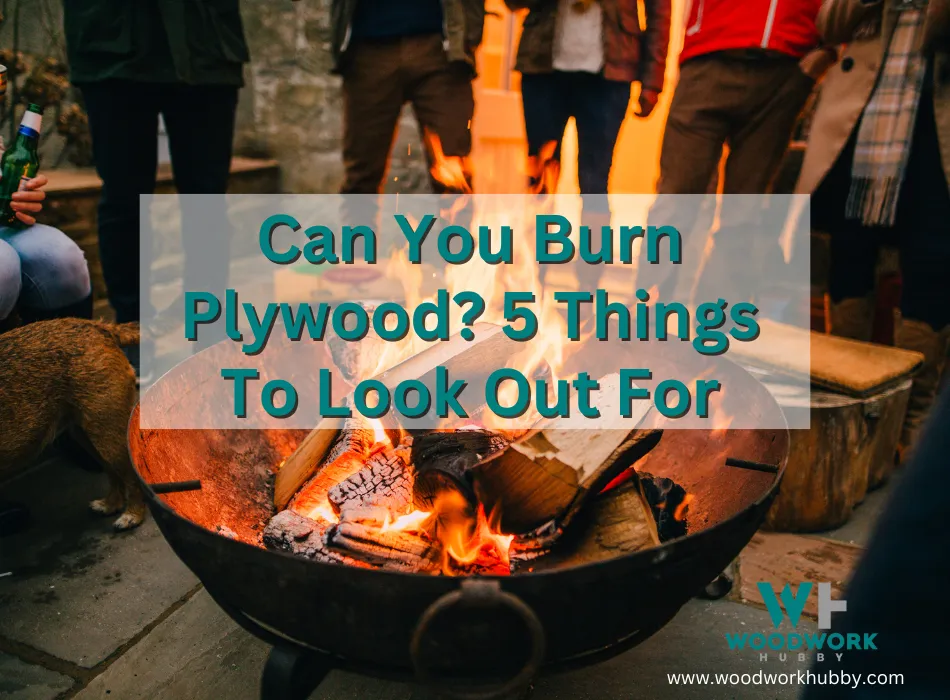You’re reading this because of one of two possible scenarios. You’re looking for firewood and are considering plywood as an option, or you’re wondering if can you burn plywood scraps like I do and you see burning as an option. Either way, you want to know if you can burn plywood.
Plywood can be burnt, but doing so will release toxic fumes and carcinogens, which is why you should not do so. Despite being able to catch fire, plywood doesn’t make for great firewood due to its negative side effects. It can be burned in smaller quantities in the open wherever burning it is legal.
If you want to get rid of old plywood scraps, you can scroll down to the section about plywood treatment, which will give you insights on whether the scraps you intend to burn qualify for this method of disposal. In case you want to use plywood as firewood, the answer is, you can’t.
But you still need firewood, and this post includes five things to look out for when getting firewood, so scrolling further down to read that is worth your time.
Can Plywood Be Used As Firewood?
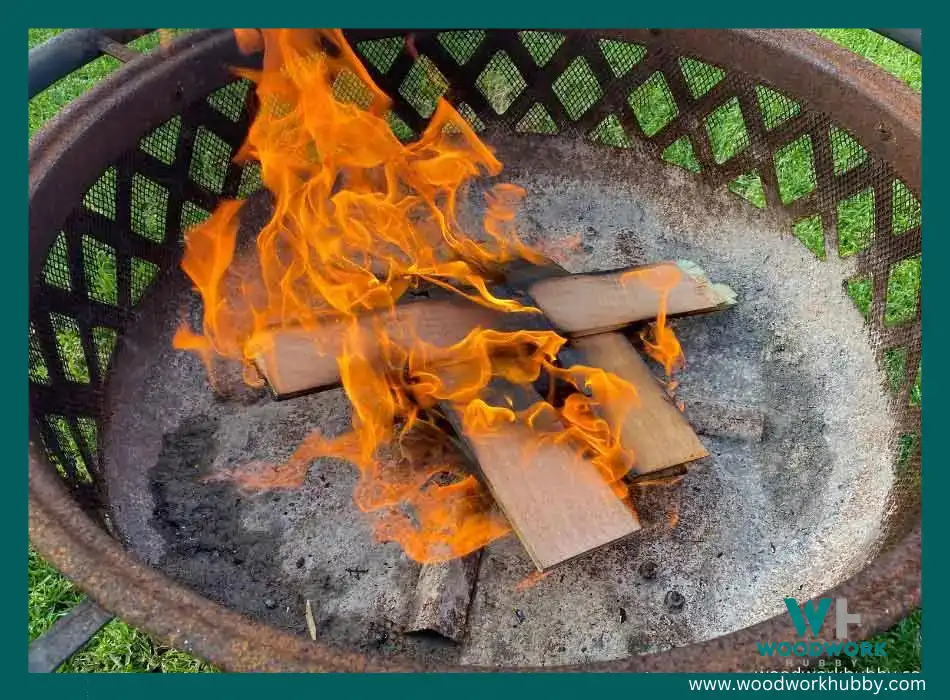
If you are like me, I often have plenty of offcuts in my woodwork shop that I have to get rid of. Most of it I burn in our outdoor firepit although I have often wondered if it is safe to use plywood as firewood.
While it might be okay to use old unfinished wood for your fireplace, you have to be wary of doing the same to your finished furniture and cabinets because they might contain chemicals and even plywood.
Plywood should not be burned as it contains glues that will release dangerous fumes when burnt. Despite looking like wood, a plywood board consists of a concoction of adhesive and preservatives alongside wood fibers. The fibers have no adverse effect when burned, but the adhesives produce toxic gases upon catching fire.
While some people dispose of their plywood by burning it in small quantities in the open, they avoid inhaling toxic fumes by not hanging around the same area in which they burn the boards. The context is different around the fireplace; you don’t burn wood there to get rid of it; you want wood that lasts and to burn it and gain heat.
I also have a lot of MDF scraps. Can you burn MDF? Read my article to see the real answer.
For that, you have to remain in close proximity to the fireplace. Given that most fireplaces are indoors even standing away doesn’t protect one from the toxic effects of inhaling glue fumes. Burning plywood also has another effect that seems trivial to mention next to the major health hazard of breathing in toxic fumes.
Did you know that you can use firewood for woodworking? Find out the details in my article.
Notwithstanding, the consequent flame from burning plywood is unnatural and leaves streaks on the surface it is close to. People have chronicled how burning plywood has ruined their fireplaces by producing sticky residue at the bottom and coating the interior of the fireplace in a purplish coat of condensed fiber glue.
Is It Okay To Burn Plywood Scraps?
When people burn plywood, it is rarely in place of firewood and mostly to get rid of old plywood scraps without incurring landfilling charges. While this method surely is cheap, it isn’t safe for the environment and one’s health.
It is not okay to burn plywood scraps in most instances because the non-wood contents of a plywood board can create toxic fumes. Most municipal regulations prohibit burning plywood in the open. When getting rid of plywood scraps, you should consider recycling, upcycling, or landfilling.
That said, there is an exception to this rule: untreated plywood. Untreated plywood isn’t as dense with adhesives and resin, the absence of which in any quantity makes the prospect a little more palatable.
Here, you have to use your own best judgment because the word “scraps” can be relative. When thinking of scraps, think small, and when thinking about the burning space, think open, and you might be able to get away with it.
If your plywood is untreated, you can burn small amounts of it
It is okay to burn plywood scraps if they are leftover from untreated plywood. Make sure not to burn them in a closed environment or over a stove, as doing so can be risky. Small leftovers of untreated plywood can be burned without inviting a lot of attention and consequent argument from neighbors.
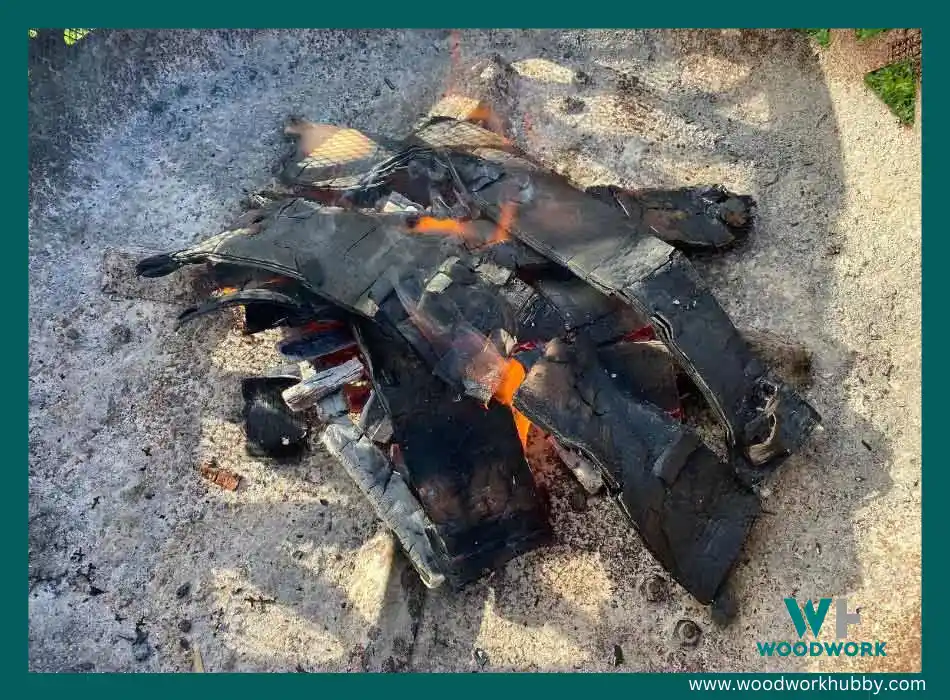
But if you do burn more plywood than you can get away with, you’ll have neighbors coughing and questioning. Fortunately, most people can’t tell the difference between plywood and hardwood. Nonetheless, it is best not to burn plywood scraps in your backyard. It is much better to use an open, uncultivated field as the burning space.
Remember, taking specific precautions regarding plywood burning does not exempt one of the general wood-burning guidelines. You still have to make sure that there is no combustible material around the fire. Moreover, you must make sure the fire is away from grass, leaves, or branches.
This is why woodworking outdoors can be great!
Finally, you must read the environment. Dry areas with a history of forest fires like California aren’t ideal for burning any kind of material out in the open. In states with large forests, playing with fire is playing with fire.
What Wood Should You Not Burn?
Speaking of fire safety, let’s pan broader than plywood and look at different types of wood that should not be burned. The simpler answer is any wood that isn’t 100% wood. But this umbrella encompasses a lot of wood types and wood boards.
Polished and sealed wood
Whether it is a stray table leg or a chopped-up bed frame, if your furniture is even slightly water-proof, it isn’t conducive to burning. Fire reacts with the thin film that coats the furniture surface and creates toxic fumes.
That said, the fumes are nowhere near the same quantity as with plywood, so burning old furniture outdoors is fine, even if it is made with polished or sealed wood.
Epoxy coated wood
Burning sealed wood outdoors is okay, but the same isn’t okay indoors. Why? Because of the concentration of the non-wood material on/in the wood, that is directly proportional to the fumes that emerge upon burning.
Epoxy-coated wood isn’t okay to burn even outdoors because the resulting fumes are much more toxic than the ones that come with burning sealed and polished wood. Moreover, epoxy doesn’t turn into vapor or gas at wood-burning temperatures. As a result, the aftermath of wood burning is an epoxy residue that is hard to remove.
Vine-covered wood
Upon reading this far, you might hesitate to burn artificially processed and polished wood. The extreme contrast to this is chopping your own firewood from trees. This, too, isn’t a 100% safe option because if the wood you shop has vines over it, it will still produce toxic fumes when burned.
Ultimately, the 100% wood rule still applies: it doesn’t matter if the “non-wood” matter is organic; it still makes the wood impure.
Let’s take the example of poison ivy (or any “poison” wood). The result of burning a vine alongside a piece of wood is the release of urushiol. That’s an oil that irritates the lungs in small quantities and can cause difficulty in breathing is present in a significant quantities.
If you have vine-covered wood and you’ve thoroughly removed the vines, you might be able to get away with burning the wood in an outdoor environment. Given that the people around the wood are far enough, the urushiol quantity will not have an impact.
But if the vine is still wrapped around the wood, it cannot be burned even in the open. It is safe only when the vine is removed completely.
In contrast, you should avoid burning wood indoors even if you have removed the vine around it because just enough of its essence is leftover on the wood that burning it indoors will cause an unbearable amount of urushiol to engulf a room.
MDF or Particle Board
Most hardwood that is free of vines is safe to burn, and most artificially processed wood isn’t. The highest in the processing hierarchy are MDF and Particle Boards, neither of which are even considered wood. The general public lumps these together with plywood though craftsmen have stopped referring to them as plywood because the term ply refers to a layer.
MDF and Particle boards feature fine fibers instead of individual layers like 2-ply or 3-ply. Instead, you have a significant amount of sawdust compressed into a solid block and held together with epoxy or alternative adhesives. The presence of adhesives makes these boards the cousins of plywood.
See my full article explaining can you burn MDF?
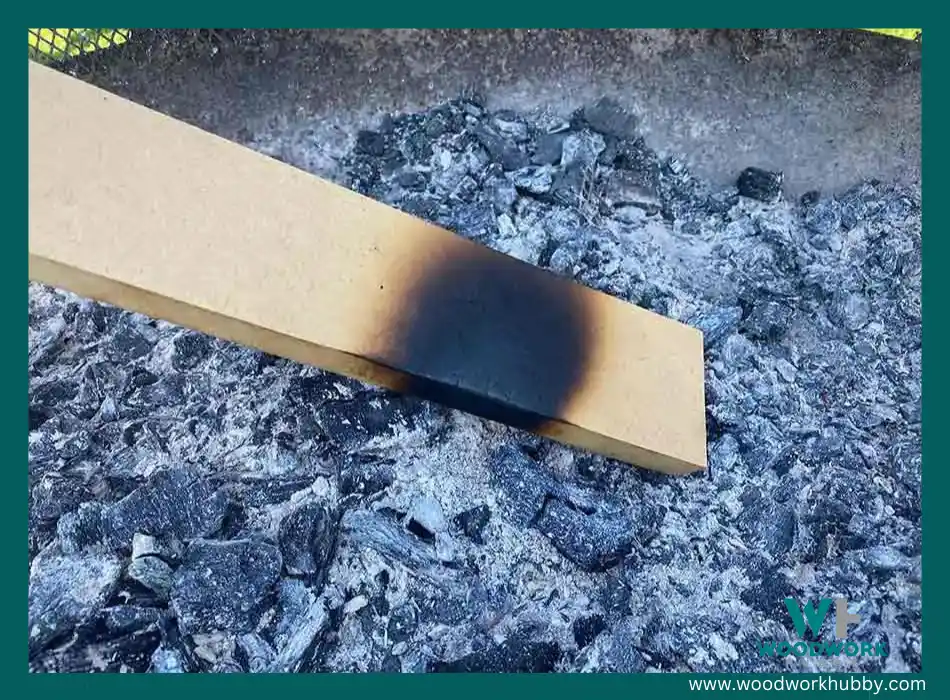
While burning standard hardwood core plywood can be problematic to an extent as well, burning MDF can be even worse. Since there are no layers of wood stuck together for the formation of an MDF or a Particle Board, the resin that holds together the fibers is in a much larger quantity.
Burning a single piece of MDF is as bad as burning 5 sheets of Plywood!
Plywood
I have to rule out burning plywood based on the same principles that make it a bad idea to burn MDF. Even though there’s a lower amount of questionable adhesive in plywood, it still is enough to make them unsuitable for use as firewood. The lower quantity, though, makes it okay to burn small scraps in the open, provided the plywood hasn’t been treated.
What Wood Should You Not Burn In A Fire Pit?
When it comes to burning wood, there are two main motives. The first is to get rid of wood, and the second is to use the wood as fuel. Since petroleum and solar power has largely replaced the need for burning wood, the only practical utility of burning it is to produce fire for leisure and warmth. From the health and safety perspective, you must not use in your fire pit any wood that is unhealthy to burn outdoors.
The following woods should NOT be burned:
- Laminated Wood
- Resin or Epoxy coated wood
- MDF (Medium Density Fibreboard)
- Plywood
- Polished Wood
- Ivy covered wood
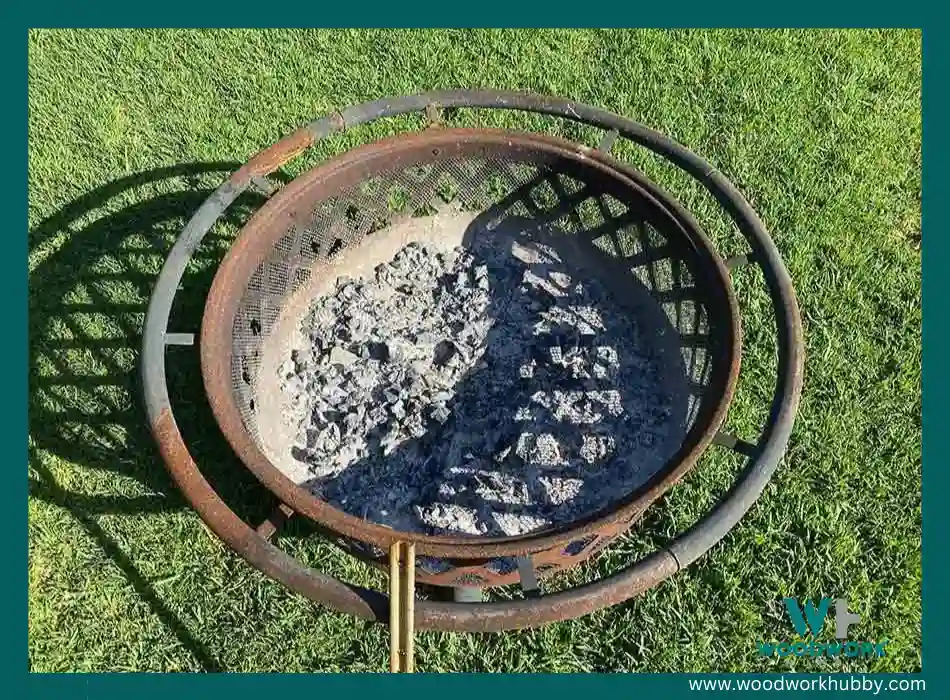
That said, there’s more to fire pit fuel specifics. You must not only look at your own health when selecting wood for a bonfire but must watch out for the health of your wallet as well. Do not burn any wood that doesn’t last a long time.
You should also consider the effect of burning different types of wood on the surroundings. With that in mind, here are the 5 types of wood you should never burn in a fire pit or a fireplace.
5 Things To Look Out For When Getting Firewood
- Damp wood – This will burn poorly and if you do get it going, it tends to smoke badly.
- Softwood – This wood has too much sap and burns with a thick smoky flame, which can leave deposits on people and surroundings.
- Damaged wood – While it might be tempting to use your ruined furniture as firewood, if it has incurred water damage and is rotting, it will make for poor firewood.
- Moldy wood – If a piece of wood is invaded by mold, avoid burning wood that’s been near it. You don’t know whether the invisible pores of mold and fungus have landed over the clear-looking wood nearby. Burning such wood pollutes the air. Find out more about Mold on Furniture in my article.
- Treated wood – When it comes to firewood, all treated wood is mistreated wood. You must opt for untreated wood as it is natural and is least likely to contain preservatives or polish that makes the wood unhealthy to burn.
Is Untreated Plywood Safe To Burn?
I concluded the 5 types of wood you should never burn, with treated wood being the final and the most problematic to burn. If treatment is such a barrier to making usable firewood, does lack of it make plywood fire-friendly?
Untreated plywood is not safe to burn, especially if burned in a fireplace. Smaller scraps of untreated plywood, on the other hand, can be safely burned if you’re a good distance away from the fire. Still, it is advisable to recycle untreated plywood instead of burning it.
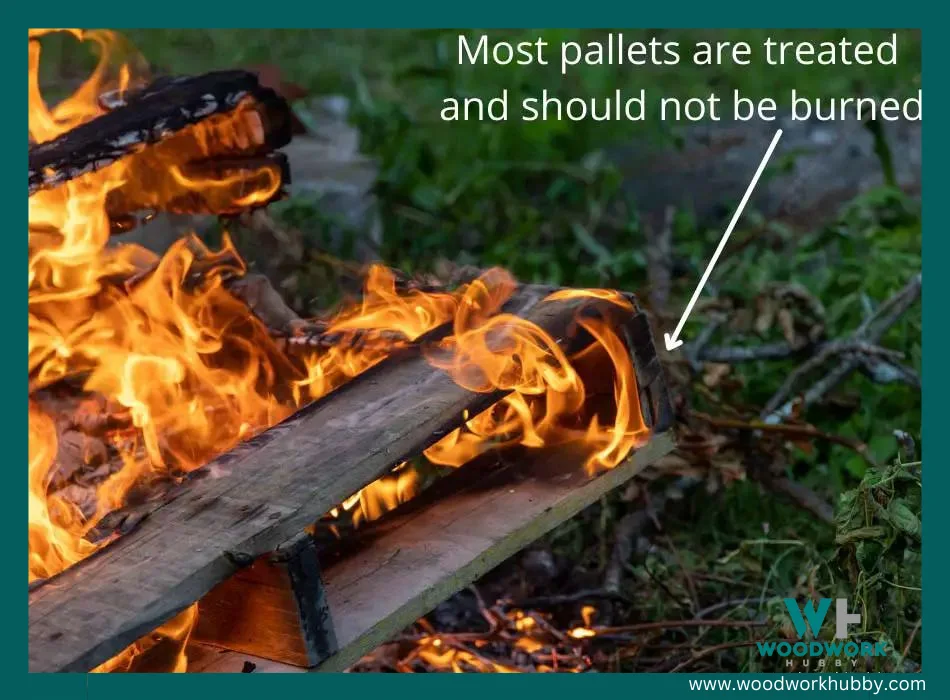
My Final Thoughts
Plywood includes wood fibers but also consists of adhesive and chemicals that are toxic to burn. Opt for pure hardwood and avoid any logs that have been artificially treated. Also, watch out for the following 5 things when getting firewood.
- Make sure it isn’t softwood.
- Ensure that the wood isn’t rotting
- Check to see if the wood has undergone chemical treatment
- Make sure the wood isn’t damp or damaged
- Check for traces of mold. Moldy wood isn’t good firewood.

